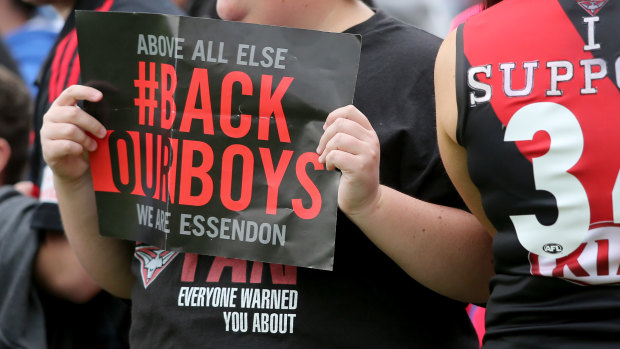By Greg Baum
The latest development in the years-long Essendon drug saga splits a hair, but it doesn't pluck it out.
The Herald Sun reports that the offending peptide Thymosin Beta-4 was listed as banned by ASADA only the day before the scandal came to light early in 2013. Implicit in this is that the players could not have known that it was banned when they were being injected in 2012.

The Essendon supplements saga continues to generate debate.Credit: Wayne Taylor
Let's follow the bouncing ball.
WADA, the international anti-drugs body, says Thymosin Beta-4 has been banned since the prohibited list was compiled in 2010, at least under a general proscription on substances that have not been explicitly approved for human use.
The ASADA list is the WADA list. ASADA says that if an Essendon player had checked the ASADA list for Thymosin Beta-4, even if he saw no red flag to say it was banned, he would have received a message to say that did not necessarily mean it was permitted and urging him to contact ASADA.
There is no evidence that any Essendon player checked. Nor has an Essendon player since claimed that he checked and was misled to believe the peptide was permitted. The balance of evidence is that most did not know with any surety what they were taking.
The AFL drugs tribunal accepted that Thymosin Beta-4 was banned. It exonerated the players on the basis that it could not establish an unbroken chain linking disgraced scientist Stephen Dank's procurement of Thymosin Beta-4 with whatever he injected into the players. In part, this was due to haphazard or non-existent paperwork.
Once again we're dwelling on a single tree that is obscuring a whole dark, dingy, dank wood.
When WADA appealed, the Court of Arbitration for Sport looked not for links in a chain, but "strands in a cable", effectively weight of circumstantial evidence. Then the patchy paperwork became damning, and the Essendon 34 went down for a year, and the club has not yet recovered.
Sloppy paperwork is an emerging theme here. When ASADA specifically added Thymosin Beta-4 to its 'Check Your Substance' website in February, 2013, it might only have been remediating a neglect, or closing a loophole. The next day, Essendon self-reported concerns with their supplements program. The rest is history that never quite passes.
This started with a split hair. At risk of excess afforestation, once again we're dwelling on a single tree that is obscuring a whole dark, dingy, dank wood.
At the time, the AFL had grave concerns with Essendon's supplements program. Essendon had concerns. They opened itself up to probes by the AFL and ASADA, and commissioned its own investigation. The investigator, Dr Ziggy Switkowski, did not mince words. "A pharmacologically experimental environment never adequately controlled or challenged or documented," he said, and of Dank: "an unguided missile".
In an interview with The Age's Nick McKenzie at the time, Dank breezily admitted to administering Thymosin Beta-4, not knowing it was banned. Dank has never answered to anyone, and is now persona non grata everywhere, leaving some waters permanently muddied.
Elsetimes, veteran club doctor Bruce Reid wrote a letter to the board enunciating his concerns. Mysteriously, it did not arrive.
Heads rolled. Lawyers massed. Friendships fractured, some never to heal. In the rush to deal with the scandal, everyone made mistakes, including the AFL. The players paid an enormous price.
Under the WADA doctrine of strict liability, it could hardly have been any other way. They were victims of a club's desperate ambition, gross mismanagement and poor internal and external advice, but not categorically of injustice.